Application of PCSWMM for the 1-D and 1-D–2-D Modeling of Urban Flooding in Damansara Catchment, Malaysia
Abstract
:1. Introduction
2. Materials and Methods
2.1. Site Description
2.2. Precipitation and Streamflow Data Collection
2.3. Model Conceptualization and Parameter Setup
3. One-Dimensional River Flow Modeling
4. One-Dimensional–Two-Dimensional Drainage Overflow Modeling
4.1. Comparison of Simulated Data and Observed Data
4.2. Comparison between Historical and Current Drainage Scenarios
5. Conclusions
- In comparison with the observations, the 1-D river flow model presents a relatively satisfactory performance in reproducing the water level peaks. The simulated and observed flow almost varies in the same trend over time, with R2, NSE, and RE values of up to 0.68, 0.52, and 4.79%, respectively.
- The 1-D–2-D drainage overflow model excellently performs in predicting the flood-prone areas, as in the historic flood event. Good agreement between the simulation and observation can be seen in the reproduction of the flood depth maxima.
- This work demonstrates the importance of drainage capacity, in which a larger size for the current drainage alleviates floods effectively, leading to a 78% reduction in the flood extent and a change from high to low risk in flood-prone areas.
Author Contributions
Funding
Institutional Review Board Statement
Informed Consent Statement
Data Availability Statement
Acknowledgments
Conflicts of Interest
Appendix A
| Name | Area (ha) | Width (m) | Flow Length (m) | Slope (%) | Imperviousness (%) |
|---|---|---|---|---|---|
| S1 | 2024.4916 | 6952.094 | 2912.06 | 1.610 | 95 |
| S2 | 700.6339 | 9060.898 | 773.25 | 0.388 | 90 |
| S3 | 507.7528 | 4794.508 | 1059.03 | 0.755 | 40 |
| S4 | 911.1001 | 3716.243 | 2451.67 | 0.326 | 40 |
| S5 | 1315.5053 | 5953.482 | 2209.64 | 0.634 | 25 |
| S6 | 714.6110 | 3105.425 | 2301.17 | 0.348 | 95 |
| S7 | 1010.6043 | 11,669.796 | 866.00 | 2.080 | 95 |
| S8 | 126.5714 | 3312.347 | 382.12 | 0.000 | 90 |
| S9 | 331.7123 | 3658.538 | 906.68 | 1.540 | 95 |
| S10 | 233.9806 | 2291.905 | 1020.90 | 1.180 | 95 |
| S11 | 211.8149 | 6898.834 | 307.03 | 0.326 | 95 |
| S12 | 277.4956 | 2583.782 | 1073.99 | 1.300 | 95 |
| S13 | 169.6048 | 7101.189 | 238.84 | 0.419 | 95 |
| S14 | 55.9358 | 7649.863 | 73.12 | 1.370 | 95 |
| S15 | 182.2992 | 2219.966 | 821.18 | 2.070 | 95 |
| S16 | 176.0004 | 2021.669 | 870.57 | 0.804 | 95 |
| S17 | 352.6336 | 3034.739 | 1161.99 | 0.172 | 40 |
| S18 | 422.6794 | 5633.547 | 750.29 | 0.800 | 95 |
| S19 | 597.2448 | 5277.646 | 1131.65 | 0.265 | 95 |
| S20 | 199.9191 | 2218.193 | 901.27 | 1.220 | 95 |
| S21 | 1432.6699 | 6144.684 | 2331.56 | 0.643 | 50 |
| S22 | 464.2521 | 5424.773 | 855.80 | 0.000 | 95 |
| S23 | 370.3168 | 6053.797 | 611.71 | 0.163 | 95 |
| S24 | 133.2000 | 1395.480 | 954.51 | 0.000 | 95 |
| S25 | 118.1376 | 5227.327 | 226.00 | 0.000 | 95 |
| S26 | 310.2076 | 3884.539 | 798.57 | 0.125 | 95 |
| S27 | 378.3916 | 2934.906 | 1289.28 | 0.310 | 95 |
| S28 | 82.3326 | 1545.166 | 532.84 | 0.938 | 40 |
| S29 | 317.6420 | 2948.857 | 1077.17 | 2.880 | 95 |
| S30 | 409.1955 | 2005.339 | 2040.53 | 1.620 | 50 |
| S31 | 184.3943 | 2776.646 | 664.09 | 0.000 | 95 |
| S32 | 71.9653 | 10,502.817 | 68.52 | 2.920 | 95 |
| S33 | 91.6950 | 1991.638 | 460.40 | 0.000 | 95 |
| S34 | 198.3507 | 2080.413 | 953.42 | 0.839 | 95 |
| S35 | 68.8886 | 5356.395 | 128.61 | 2.330 | 95 |
| Name | Area (ha) | Width (m) | Flow Length (m) | Slope (%) | Imperviousness (%) |
|---|---|---|---|---|---|
| S1 | 3.1546 | 162.978 | 193.56 | 1.550 | 90 |
| S2 | 1.9113 | 180.977 | 105.61 | 1.890 | 50 |
| S3 | 1.6606 | 207.679 | 79.96 | 5.000 | 90 |
| S4 | 5.2218 | 274.168 | 190.46 | 0.525 | 90 |
| S5 | 5.2727 | 270.547 | 194.89 | 2.060 | 90 |
| S6 | 6.8840 | 352.375 | 195.36 | 1.540 | 90 |
| S7 | 7.9970 | 857.128 | 93.30 | 5.460 | 90 |
| S8 | 7.5877 | 1192.472 | 63.63 | 2.980 | 90 |
| S9 | 7.6306 | 296.633 | 257.24 | 0.777 | 90 |
| S10 | 5.9783 | 261.667 | 228.47 | 0.438 | 90 |
| S11 | 4.8595 | 364.444 | 133.34 | 0.750 | 90 |
| S12 | 3.0559 | 183.295 | 166.72 | 0.600 | 90 |
| S13 | 6.3714 | 344.065 | 185.18 | 0.540 | 90 |
| S14 | 3.8718 | 197.098 | 196.44 | 0.509 | 90 |
| S15 | 3.7131 | 366.545 | 101.30 | 1.970 | 90 |
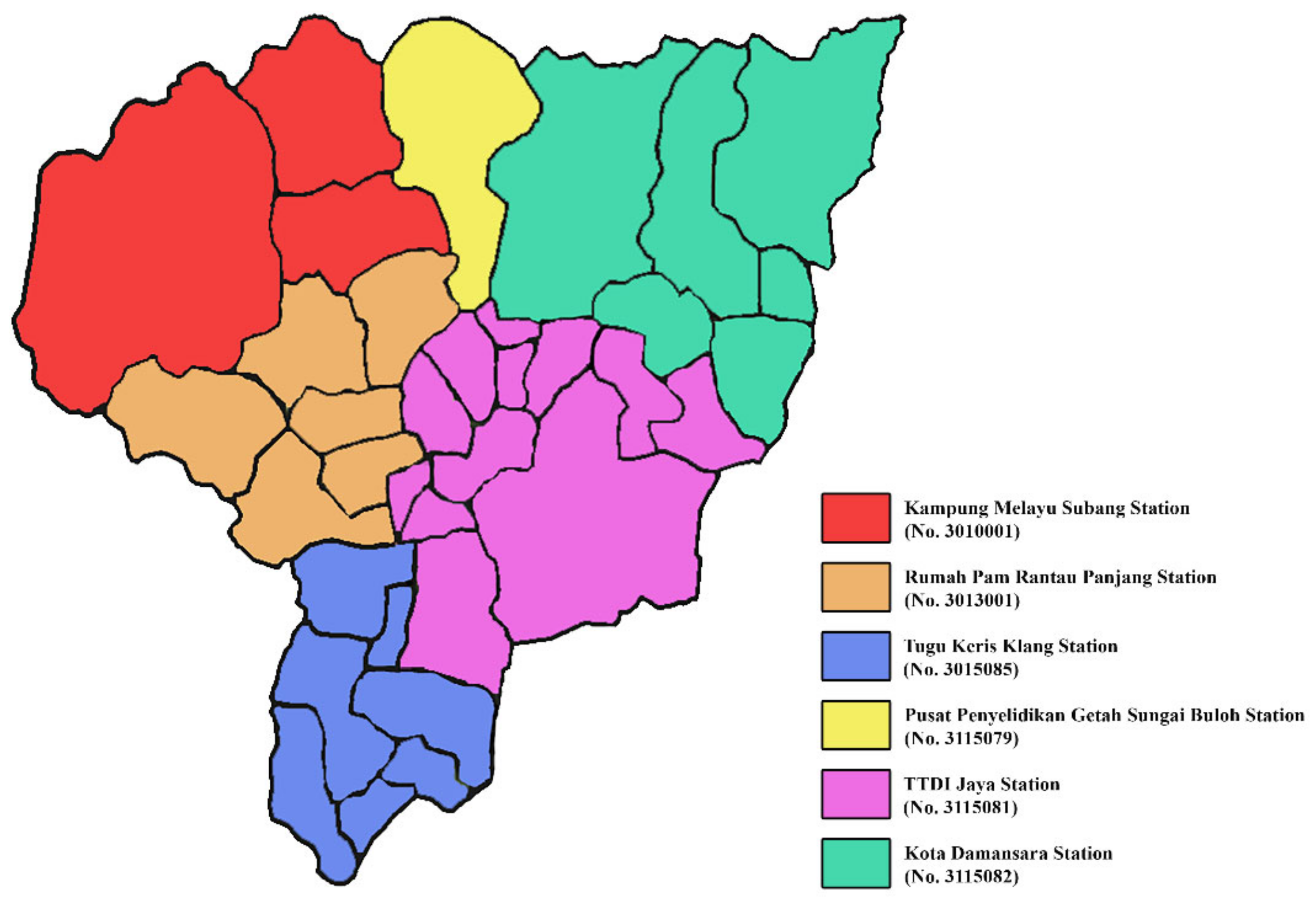


References
- Abedin, S.J.H.; Stephen, H. GIS framework for spatiotemporal mapping of urban flooding. Geosciences 2019, 9, 77. [Google Scholar] [CrossRef] [Green Version]
- Berndtsson, R.; Becker, P.; Persson, A.; Aspegren, H.; Haghighatafshar, S.; Jönsson, K.; Larsson, R.; Mobini, S.; Mottaghi, M.; Nilsson, J. Drivers of changing urban flood risk: A framework for action. J. Environ. Manag. 2019, 240, 47–56. [Google Scholar] [CrossRef] [PubMed]
- Kwak, D.; Kim, H.; Han, M. Runoff control potential for design types of low impact development in small developing area using XPSWMM. Procedia Eng. 2016, 154, 1324–1332. [Google Scholar] [CrossRef] [Green Version]
- Morris, K.I.; Chan, A.; Morris, K.J.K.; Ooi, M.C.; Oozeer, M.Y.; Abakr, Y.A.; Nadzir, M.S.M.; Mohammed, I.Y.; Al-Qrimli, H.F. Impact of urbanization level on the interactions of urban area, the urban climate, and human thermal comfort. Appl. Geogr. 2017, 79, 50–72. [Google Scholar] [CrossRef]
- Mustaffa, C.S.; Marzuki, N.A.; Khalid, M.S.; Sakdan, M.F.; Sipon, S. Understanding Malaysian Malays communication characteristics in reducing psychological impact on flood victims. J. Komun. Malays. J. Commun. 2018, 34, 20–36. [Google Scholar] [CrossRef] [Green Version]
- Teng, J.; Jakeman, A.J.; Vaze, J.; Croke, B.F.; Dutta, D.; Kim, S. Flood inundation modelling: A review of methods, recent advances and uncertainty analysis. Environ. Model. Softw. 2017, 90, 201–216. [Google Scholar] [CrossRef]
- DID. Preparation of Flood Mitigation Master Plan for Sungai Damansara Catchment; Department of Irrigation and Drainage Malaysia: Kuala Lumpur, Malaysia, 2008. [Google Scholar]
- DID. Ringkasan Laporan Banjir Tahunan Bagi Tahun 2015/2016; Department of Irrigation and Drainage Malaysia: Kuala Lumpur, Malaysia, 2016. [Google Scholar]
- BNNW. These Are the Flood Hotspots in the Klang Valley. Available online: https://www.brudirect.com/news.php?id=82199 (accessed on 3 January 2021).
- Metcalf, E. Storm Water Management Model; University of Florida and Water Resources Engineers, Environmental Protection Agency: Washington, DC, USA, 1971. [Google Scholar]
- Guan, M.; Sillanpää, N.; Koivusalo, H. Modelling and assessment of hydrological changes in a developing urban catchment. Hydrol. Process. 2015, 29, 2880–2894. [Google Scholar] [CrossRef]
- Jang, S.; Cho, M.; Yoon, J.; Yoon, Y.; Kim, S.; Kim, G.; Kim, L.; Aksoy, H. Using SWMM as a tool for hydrologic impact assessment. Desalination 2007, 212, 344–356. [Google Scholar] [CrossRef]
- Palla, A.; Gnecco, I. Hydrologic modeling of Low Impact Development systems at the urban catchment scale. J. Hydrol. 2015, 528, 361–368. [Google Scholar] [CrossRef]
- Yazdi, M.N.; Ketabchy, M.; Sample, D.J.; Scott, D.; Liao, H. An evaluation of HSPF and SWMM for simulating streamflow regimes in an urban watershed. Environ. Model. Softw. 2019, 118, 211–225. [Google Scholar] [CrossRef]
- Mao, D.; Cherkauer, K.A. Impacts of land-use change on hydrologic responses in the Great Lakes region. J. Hydrol. 2009, 374, 71–82. [Google Scholar] [CrossRef]
- Sun, N.; Hall, M.; Hong, B.; Zhang, L. Impact of SWMM catchment discretization: Case study in Syracuse, New York. J. Hydrol. Eng. 2014, 19, 223–234. [Google Scholar] [CrossRef]
- Lee, S.-B.; Yoon, C.-G.; Jung, K.W.; Hwang, H.S. Comparative evaluation of runoff and water quality using HSPF and SWMM. Water Sci. Technol. 2010, 62, 1401–1409. [Google Scholar] [CrossRef] [PubMed]
- Alamdari, N.; Sample, D.J.; Steinberg, P.; Ross, A.C.; Easton, Z.M. Assessing the effects of climate change on water quantity and quality in an urban watershed using a calibrated stormwater model. Water 2017, 9, 464. [Google Scholar] [CrossRef]
- Abdul-Aziz, O.I.; Al-Amin, S. Climate, land use and hydrologic sensitivities of stormwater quantity and quality in a complex coastal-urban watershed. Urban Water J. 2016, 13, 302–320. [Google Scholar] [CrossRef]
- Rai, P.K.; Chahar, B.; Dhanya, C. GIS-based SWMM model for simulating the catchment response to flood events. Hydrol. Res. 2017, 48, 384–394. [Google Scholar] [CrossRef]
- Yu, H.; Huang, G.; Wu, C. Application of the stormwater management model to a piedmont city: A case study of Jinan City, China. Water Sci. Technol. 2014, 70, 858–864. [Google Scholar] [CrossRef]
- Wanniarachchi, S.; Wijesekera, N. Using SWMM as a tool for floodplain management in ungauged urban watershed. Eng. J. Inst. Eng. Sri Lanka 2012, 45, 1–8. [Google Scholar] [CrossRef] [Green Version]
- Bisht, D.S.; Chatterjee, C.; Kalakoti, S.; Upadhyay, P.; Sahoo, M.; Panda, A. Modeling urban floods and drainage using SWMM and MIKE URBAN: A case study. Nat. Hazards 2016, 84, 749–776. [Google Scholar] [CrossRef]
- Ermalizar, L.M.; Junaidi, A. Flood simulation using EPA SWMM 5.1 on small catchment urban drainage system. MATEC Web Conf. 2018, 229, 04022. [Google Scholar]
- Paule-Mercado, M.; Lee, B.; Memon, S.; Umer, S.; Salim, I.; Lee, C.-H. Influence of land development on stormwater runoff from a mixed land use and land cover catchment. Sci. Total Environ. 2017, 599, 2142–2155. [Google Scholar] [CrossRef]
- Yim, S.; Aing, C.; Men, S.; Sovann, C. Applying PCSWMM for stormwater management in the Wat Phnom sub catchment, Phnom Penh, Cambodia. J. Geogr. Environ. Earth Sci. Int. 2016, 5, 1–11. [Google Scholar] [CrossRef]
- Irvine, K.; Sovann, C.; Suthipong, S.; Kok, S.; Chea, E. Application of PCSWMM to assess wastewater treatment and urban flooding scenarios in Phnom Penh, Cambodia: A tool to support eco-city planning. J. Water Manag. Model. 2015, 23, 1–13. [Google Scholar] [CrossRef]
- Hamouz, V.; Møller-Pedersen, P.; Muthanna, T.M. Modelling runoff reduction through implementation of green and grey roofs in urban catchments using PCSWMM. Urban Water J. 2020, 17, 813–826. [Google Scholar] [CrossRef]
- Peng, Z.; Jinyan, K.; Wenbin, P.; Xin, Z.; Yuanbin, C. Effects of Low-Impact Development on Urban Rainfall Runoff under Different Rainfall Characteristics. Pol. J. Environ. Stud. 2019, 28, 771–783. [Google Scholar] [CrossRef]
- Bhowmick, A.; Irvine, K.; Jindal, R. Mathematical modeling of effluent quality of cha-Am municipality wastewater treatment pond system using PCSWMM. J. Water Manag. Model. 2017, 25, 1–9. [Google Scholar] [CrossRef] [Green Version]
- Panos, C.L.; Wolfand, J.M.; Hogue, T.S. Assessing resilience of a dual drainage urban system to redevelopment and climate change. J. Hydrol. 2021, 596, 126101. [Google Scholar] [CrossRef]
- Akhter, M.S.; Hewa, G.A. The use of PCSWMM for assessing the impacts of land use changes on hydrological responses and performance of WSUD in managing the impacts at Myponga catchment, South Australia. Water 2016, 8, 511. [Google Scholar] [CrossRef]
- Liwanag, F.; Mostrales, D.S.; Ignacio, M.T.T.; Orejudos, J.N. Flood modeling using GIS and PCSWMM. Eng. J. 2018, 22, 279–289. [Google Scholar] [CrossRef]
- Kumar, S.; Kaushal, D.; Gosain, A. Assessment of Stormwater Drainage Network to Mitigate Urban Flooding Using GIS Compatible PCSWMM Model. In Urbanization Challenges in Emerging Economies: Energy and Water Infrastructure, Transportation Infrastructure, and Planning and Financing; American Society of Civil Engineers: Reston, VA, USA, 2018; pp. 38–46. [Google Scholar]
- Hasan, H.H.; Mohd Razali, S.F.; Ahmad Zaki, A.Z.I.; Mohamad Hamzah, F. Integrated hydrological-hydraulic model for flood simulation in tropical urban catchment. Sustainability 2019, 11, 6700. [Google Scholar] [CrossRef] [Green Version]
- Sidek, L.M.; Zaki, A.Z.I.A.; Puad, A.H.M.; Mustaffa, Z. Comparison of Design Flood Hydrograph Using XP-SWMM in Jeluh River, Kajang for Flood Mitigation. In Water Resources Development and Management; Springer: Singapore, 2019; pp. 613–624. [Google Scholar]
- Searcy, J.; Hardison, C. Double-Mass Curves. Manual of Hydrology: Part I, General Surface Water Techniques; United States Geological Survey: Washington, DC, USA, 1960. [Google Scholar]
- Rossman, L.A. Storm Water Management Model User’s Manual, Version 5.0; National Risk Management Research Laboratory, Office of Research and Development, US Environmental Protection Agency: Cincinnati, OH, USA, 2010. [Google Scholar]
- DID. Urban Stormwater Management Manual for Malaysia; Department of Irrigation and Drainage Malaysia: Kuala Lumpur, Malaysia, 2012. [Google Scholar]
- Horton, R.E. An approach toward a physical interpretation of infiltration–capacity. Soil Sci. Soc. Am. J. 1941, 5, 399–417. [Google Scholar] [CrossRef]
- DID. Design Flood Hydrograph Estimation for Rural Catchments in Peninsular Malaysia; Department of Irrigation and Drainage Malaysia: Kuala Lumpur, Malaysia, 2018. [Google Scholar]
- Tiwari, S.; Jha, S.K.; Singh, A. Quantification of node importance in rain gauge network: Influence of temporal resolution and rain gauge density. Sci. Rep. 2020, 10, 9761. [Google Scholar] [CrossRef] [PubMed]
- Sidek, L.M.; Jaafar, A.S.; Majid, W.H.A.W.A.; Basri, H.; Marufuzzaman, M.; Fared, M.M.; Moon, W.C. High-resolution hydrological-hydraulic modeling of urban floods using InfoWorks ICM. Sustainability 2021, 13, 10259. [Google Scholar] [CrossRef]
- Pinos, J.; Timbe, L. Performance assessment of two-dimensional hydraulic models for generation of flood inundation maps in mountain river basins. Water Sci. Eng. 2019, 12, 11–18. [Google Scholar] [CrossRef]
- CHI. PCSWMM Manual; 2292-6062; Computational Hydraulics International: Guelph, ON, Canada, 2018. [Google Scholar]
- Li, J.; Wong, D.W. Effects of DEM sources on hydrologic applications. Comput. Environ. Urban Syst. 2010, 34, 251–261. [Google Scholar] [CrossRef]
- IPCC. Climate Change 2014: Synthesis Report. Contribution of Working Groups I, II and III to the Fifth Assessment Report of the Intergovernmental Panel on Climate Change; Intergovernmental Panel on Climate Change: Geneva, Switzerland, 2014. [Google Scholar]
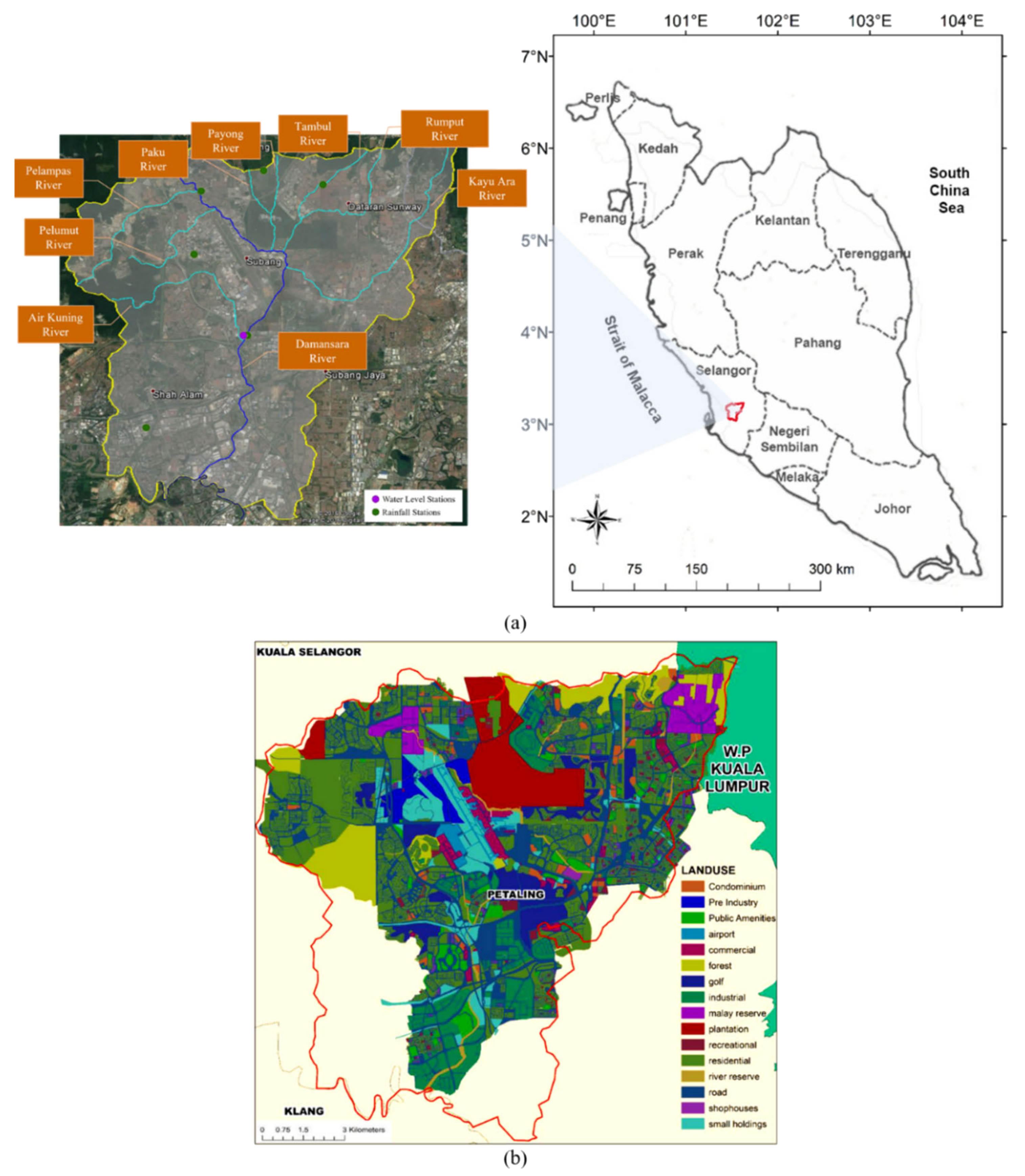
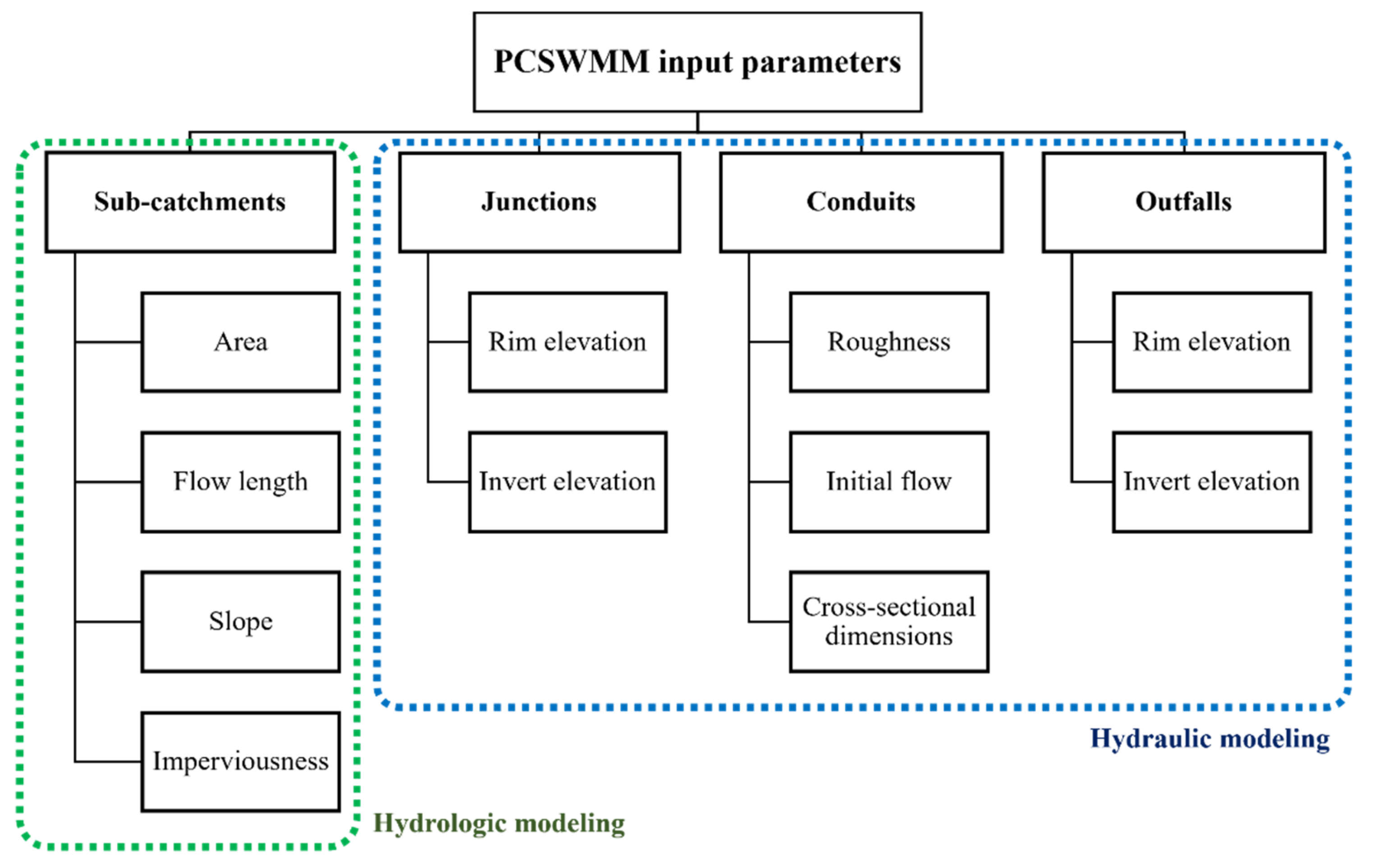
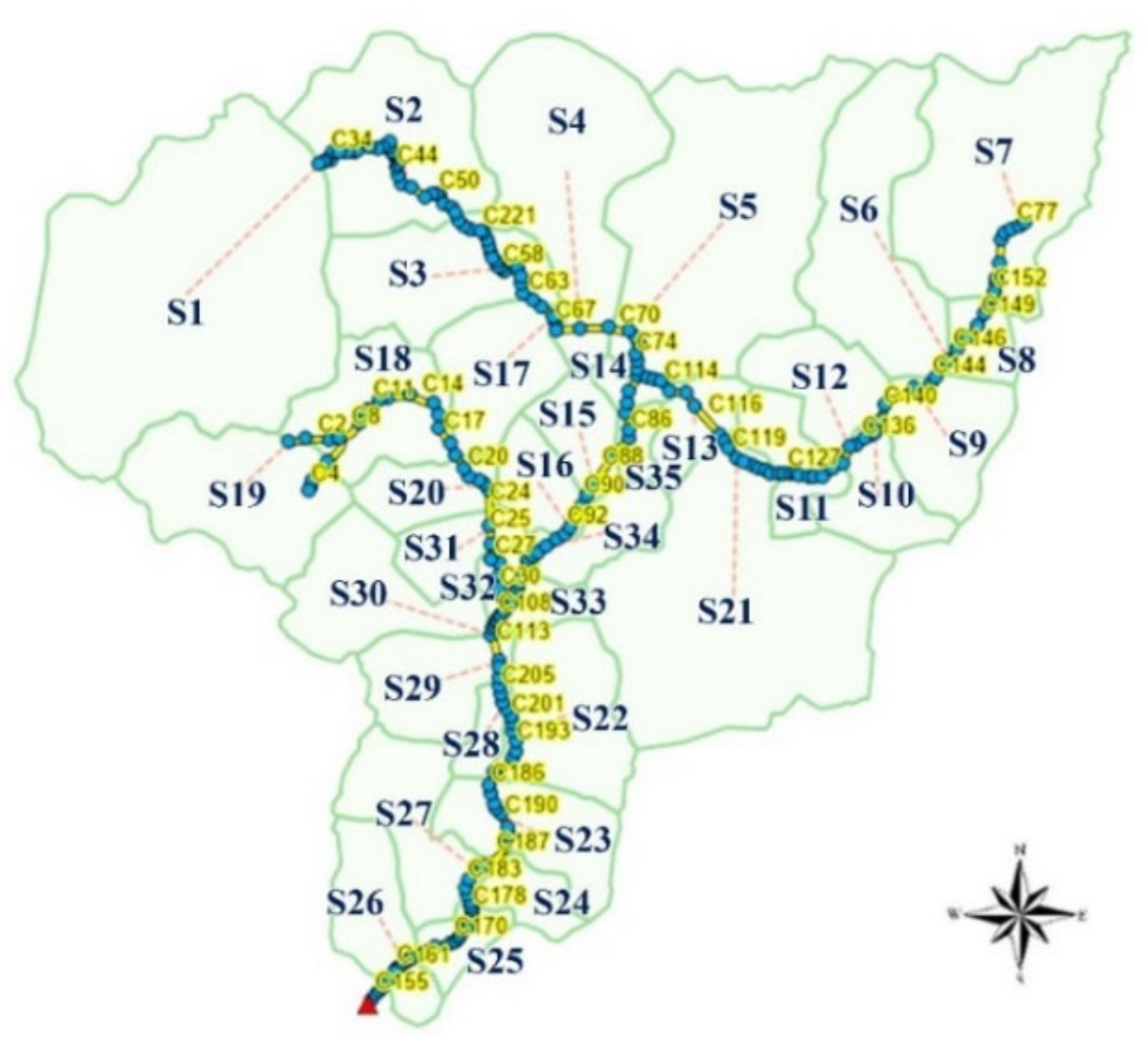

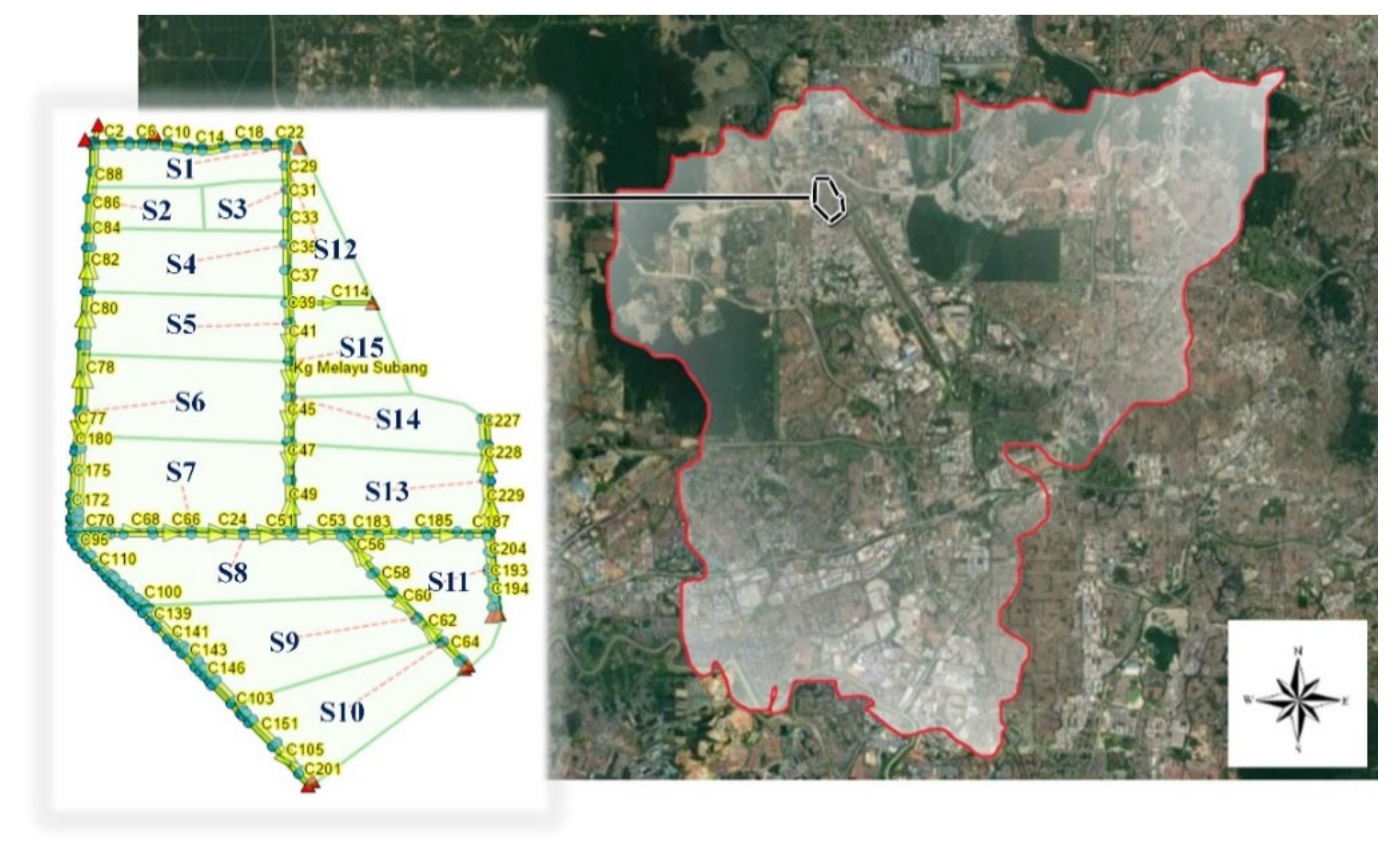
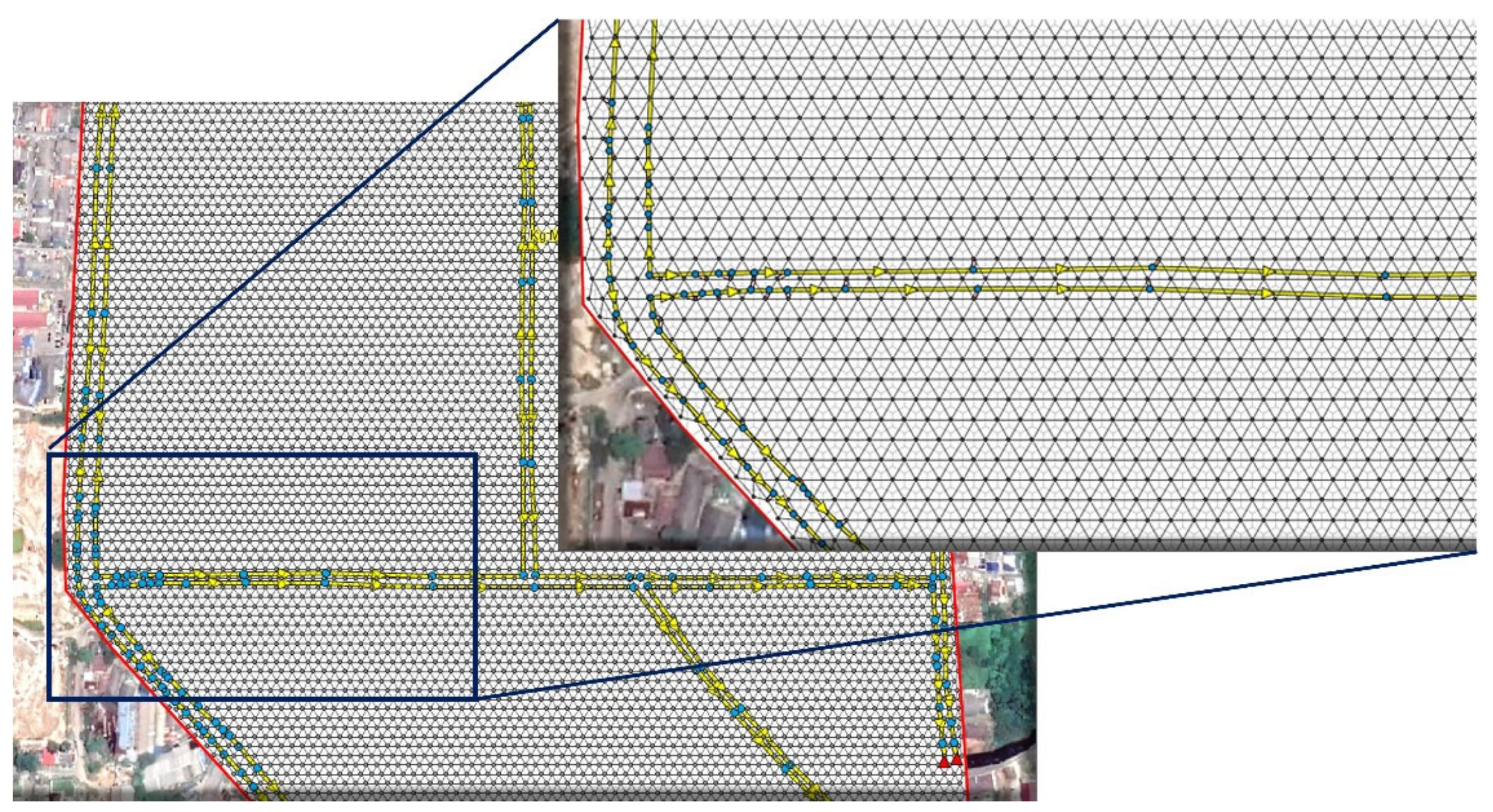
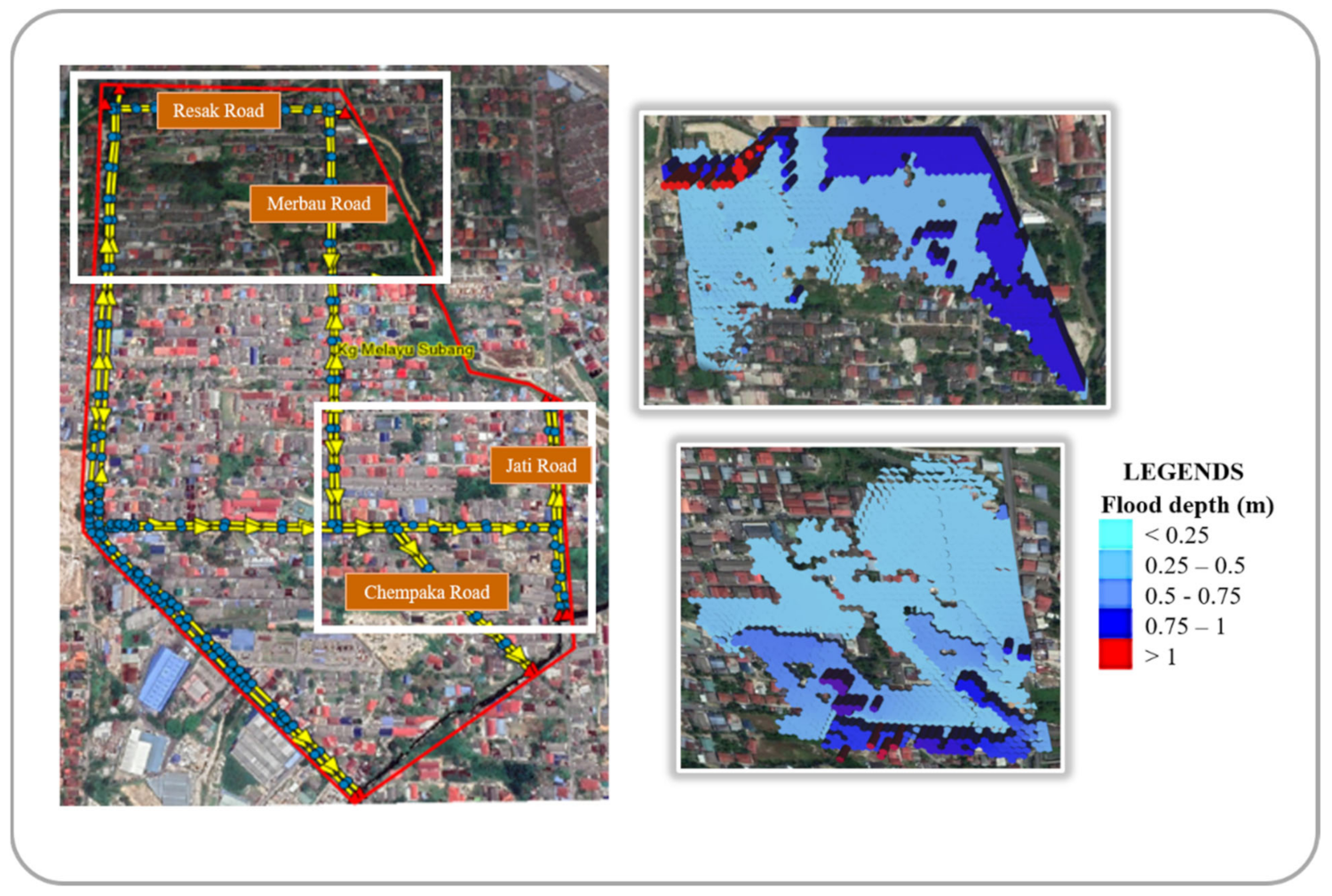

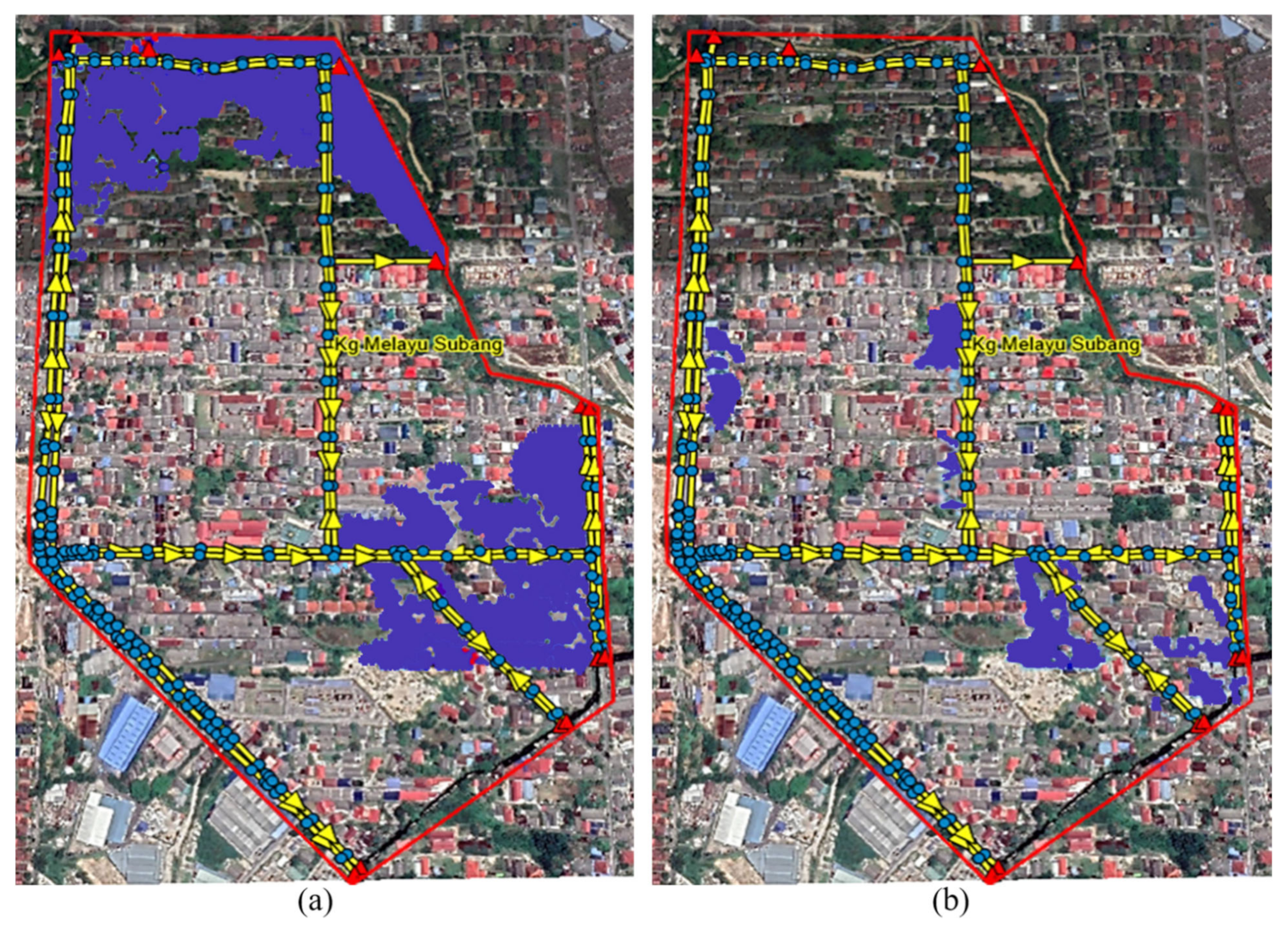

| Average Total Precipitation (mm) | Flood Duration (h) | Lowest Flood Depth (m) | Highest Flood Depth (m) | Flood Extent (km2) | |
|---|---|---|---|---|---|
| Mean | 70.85 | 1.92 | 0.26 | 0.62 | 0.37 |
| Median | 71.00 | 2.00 | 0.30 | 0.55 | 0.03 |
| Standard deviation | 24.86 | 0.77 | 0.18 | 0.30 | 1.20 |
| Minimum | 31.00 | 0.50 | 0.10 | 0.30 | 0.00 |
| Maximum | 104.00 | 3.50 | 0.60 | 1.00 | 5.00 |
| Sum | 2338.00 | 36.50 | 8.20 | 19.80 | 12.27 |
| Count | 33 | 19 | 32 | 32 | 33 |
| Rainfall Station No. | Water Level Station No. | Station Name | Latitude | Longitude | Standard Deviation | Skewness | Kurtosis | Maximum Rainfall |
|---|---|---|---|---|---|---|---|---|
| 3010001 | - | Kampung Melayu Subang | 03°09′29″ | 101°32′04″ | 14.05 | 3.23 | 13.41 | 134.50 |
| 3013001 | - | Rumah Pam Rantau Panjang | 03°07′51″ | 101°31′59″ | 13.40 | 3.63 | 18.71 | 171.40 |
| 3015085 | - | Tugu Keris Klang | 03°03′29″ | 101°30′59″ | 12.44 | 3.79 | 18.36 | 116.60 |
| 3115079 | - | Pusat Penyelidikan Getah Sungai Buloh | 03°10′02″ | 101°33′35″ | 14.67 | 2.84 | 9.57 | 113.50 |
| 3115081 | 3015490 | TTDI Jaya | 03°06′18″ | 101°33′49″ | 15.42 | 3.20 | 12.79 | 143.50 |
| 3115082 | - | Kota Damansara | 03°09′39″ | 101°34′59″ | 15.22 | 2.92 | 10.04 | 123.40 |
| Period | R2 | NSE | RE (%) | |||
|---|---|---|---|---|---|---|
| PCSWMM | InfoWorks ICM | PCSWMM | InfoWorks ICM | PCSWMM | InfoWorks ICM | |
| Calibration | 0.68 | 0.47 | 0.52 | 0.42 | 4.79 | −3.74 |
| Validation | 0.62 | 0.56 | 0.10 | 0.26 | 10.58 | 9.28 |
Publisher’s Note: MDPI stays neutral with regard to jurisdictional claims in published maps and institutional affiliations. |
© 2021 by the authors. Licensee MDPI, Basel, Switzerland. This article is an open access article distributed under the terms and conditions of the Creative Commons Attribution (CC BY) license (https://creativecommons.org/licenses/by/4.0/).
Share and Cite
Sidek, L.M.; Chua, L.H.C.; Azizi, A.S.M.; Basri, H.; Jaafar, A.S.; Moon, W.C. Application of PCSWMM for the 1-D and 1-D–2-D Modeling of Urban Flooding in Damansara Catchment, Malaysia. Appl. Sci. 2021, 11, 9300. https://doi.org/10.3390/app11199300
Sidek LM, Chua LHC, Azizi ASM, Basri H, Jaafar AS, Moon WC. Application of PCSWMM for the 1-D and 1-D–2-D Modeling of Urban Flooding in Damansara Catchment, Malaysia. Applied Sciences. 2021; 11(19):9300. https://doi.org/10.3390/app11199300
Chicago/Turabian StyleSidek, Lariyah Mohd, Lloyd Hock Chye Chua, Aqilah Syasya Mohd Azizi, Hidayah Basri, Aminah Shakirah Jaafar, and Wei Chek Moon. 2021. "Application of PCSWMM for the 1-D and 1-D–2-D Modeling of Urban Flooding in Damansara Catchment, Malaysia" Applied Sciences 11, no. 19: 9300. https://doi.org/10.3390/app11199300
APA StyleSidek, L. M., Chua, L. H. C., Azizi, A. S. M., Basri, H., Jaafar, A. S., & Moon, W. C. (2021). Application of PCSWMM for the 1-D and 1-D–2-D Modeling of Urban Flooding in Damansara Catchment, Malaysia. Applied Sciences, 11(19), 9300. https://doi.org/10.3390/app11199300







